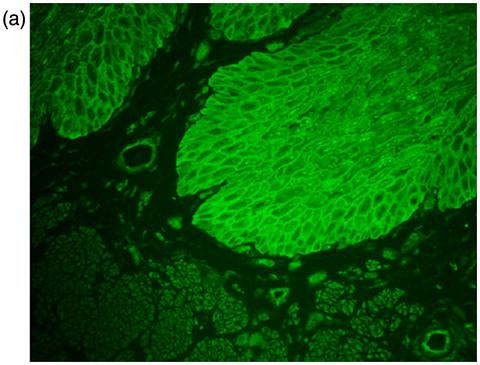当前位置:
X-MOL 学术
›
Clin. Exp. Immunol.
›
论文详情
Our official English website, www.x-mol.net, welcomes your
feedback! (Note: you will need to create a separate account there.)
Establishing the prevalence of common tissue-specific autoantibodies following severe acute respiratory syndrome coronavirus 2 infection
Clinical & Experimental Immunology ( IF 3.4 ) Pub Date : 2021-06-03 , DOI: 10.1111/cei.13623 Alex G Richter 1 , Adrian M Shields 1 , Abid Karim 1 , David Birch 1 , Sian E Faustini 1 , Lora Steadman 2 , Kerensa Ward 1 , Timothy Plant 1 , Gary Reynolds 2 , Tonny Veenith 3 , Adam F Cunningham 2 , Mark T Drayson 1 , David C Wraith 2
Clinical & Experimental Immunology ( IF 3.4 ) Pub Date : 2021-06-03 , DOI: 10.1111/cei.13623 Alex G Richter 1 , Adrian M Shields 1 , Abid Karim 1 , David Birch 1 , Sian E Faustini 1 , Lora Steadman 2 , Kerensa Ward 1 , Timothy Plant 1 , Gary Reynolds 2 , Tonny Veenith 3 , Adam F Cunningham 2 , Mark T Drayson 1 , David C Wraith 2
Affiliation

|
Coronavirus 19 (COVID-19) has been associated with both transient and persistent systemic symptoms that do not appear to be a direct consequence of viral infection. The generation of autoantibodies has been proposed as a mechanism to explain these symptoms. To understand the prevalence of autoantibodies associated with severe acute respiratory syndrome coronavirus 2 (SARS-CoV-2) infection, we investigated the frequency and specificity of clinically relevant autoantibodies in 84 individuals previously infected with SARS-CoV-2, suffering from COVID-19 of varying severity in both the acute and convalescent setting. These were compared with results from 32 individuals who were on the intensive therapy unit (ITU) for non-COVID reasons. We demonstrate a higher frequency of autoantibodies in the COVID-19 ITU group compared with non-COVID-19 ITU disease control patients and that autoantibodies were also found in the serum 3–5 months post-COVID-19 infection. Non-COVID patients displayed a diverse pattern of autoantibodies; in contrast, the COVID-19 groups had a more restricted panel of autoantibodies including skin, skeletal muscle and cardiac antibodies. Our results demonstrate that respiratory viral infection with SARS-CoV-2 is associated with the detection of a limited profile of tissue-specific autoantibodies, detectable using routine clinical immunology assays. Further studies are required to determine whether these autoantibodies are specific to SARS-CoV-2 or a phenomenon arising from severe viral infections and to determine the clinical significance of these autoantibodies.
中文翻译:

确定严重急性呼吸综合征冠状病毒 2 感染后常见组织特异性自身抗体的流行率
冠状病毒 19 (COVID-19) 与短暂和持续的全身症状有关,这些症状似乎不是病毒感染的直接后果。自身抗体的产生已被提议作为解释这些症状的机制。为了了解与严重急性呼吸综合征冠状病毒 2 (SARS-CoV-2) 感染相关的自身抗体的流行情况,我们调查了 84 名既往感染过 SARS-CoV-2、患有 COVID-19 的个体中临床相关自身抗体的频率和特异性。在急性和恢复期都有不同的严重程度。这些结果与 32 名因非新冠原因而入住强化治疗室 (ITU) 的患者的结果进行了比较。我们证明,与非 COVID-19 ITU 疾病控制患者相比,COVID-19 ITU 组中自身抗体出现的频率更高,并且在 COVID-19 感染后 3-5 个月的血清中也发现了自身抗体。非新冠肺炎患者表现出多种自身抗体模式;相比之下,COVID-19 组的自身抗体范围更有限,包括皮肤、骨骼肌和心脏抗体。我们的结果表明,SARS-CoV-2 呼吸道病毒感染与有限的组织特异性自身抗体的检测有关,可以使用常规临床免疫学检测来检测。需要进一步的研究来确定这些自身抗体是否针对 SARS-CoV-2 或严重病毒感染引起的现象,并确定这些自身抗体的临床意义。
更新日期:2021-07-12
中文翻译:

确定严重急性呼吸综合征冠状病毒 2 感染后常见组织特异性自身抗体的流行率
冠状病毒 19 (COVID-19) 与短暂和持续的全身症状有关,这些症状似乎不是病毒感染的直接后果。自身抗体的产生已被提议作为解释这些症状的机制。为了了解与严重急性呼吸综合征冠状病毒 2 (SARS-CoV-2) 感染相关的自身抗体的流行情况,我们调查了 84 名既往感染过 SARS-CoV-2、患有 COVID-19 的个体中临床相关自身抗体的频率和特异性。在急性和恢复期都有不同的严重程度。这些结果与 32 名因非新冠原因而入住强化治疗室 (ITU) 的患者的结果进行了比较。我们证明,与非 COVID-19 ITU 疾病控制患者相比,COVID-19 ITU 组中自身抗体出现的频率更高,并且在 COVID-19 感染后 3-5 个月的血清中也发现了自身抗体。非新冠肺炎患者表现出多种自身抗体模式;相比之下,COVID-19 组的自身抗体范围更有限,包括皮肤、骨骼肌和心脏抗体。我们的结果表明,SARS-CoV-2 呼吸道病毒感染与有限的组织特异性自身抗体的检测有关,可以使用常规临床免疫学检测来检测。需要进一步的研究来确定这些自身抗体是否针对 SARS-CoV-2 或严重病毒感染引起的现象,并确定这些自身抗体的临床意义。











































 京公网安备 11010802027423号
京公网安备 11010802027423号